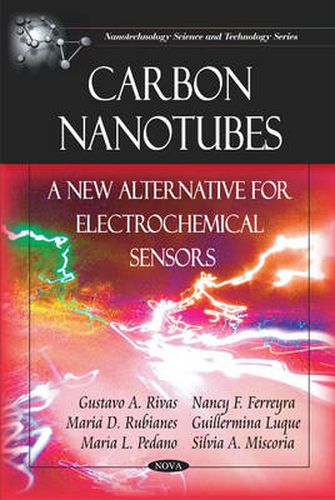Readings Newsletter
Become a Readings Member to make your shopping experience even easier.
Sign in or sign up for free!
You’re not far away from qualifying for FREE standard shipping within Australia
You’ve qualified for FREE standard shipping within Australia
The cart is loading…






The goal of this book is to summarise the recent advances in carbon nanotubes as a new material for electrochemical sensors. Since their discovery in 1991, carbon nanotubes have received considerable attention in different fields. Their special geometry and unique electronic, mechanical, chemical and thermal properties make them a very attractive material for the design of electrochemical biosensors. The first application of carbon nanotubes in the preparation of a sensor was reported by Britto in 1996. Since then, an increasing number of publications involving sensors based on carbon nanotubes (either single or multi-wall) for substrates like glucose, lactate, alcohols, phenols, neurotransmitters, aminoacids, proteins, carbohydrates among others, have been reported. This fact demonstrates the usefulness of carbon nanotubes for the development of electrochemical sensors. The advantages of carbon nanotubes for promoting electron transfer reactions -with special emphasis in those involving biomolecules, the different methodologies for incorporating carbon nanotubes in sensors (either suspended in solutions, in polymeric films or in composite matrices), the analytical performance of the resulting biosensors as well as future prospects are discussed in this book.
$9.00 standard shipping within Australia
FREE standard shipping within Australia for orders over $100.00
Express & International shipping calculated at checkout
The goal of this book is to summarise the recent advances in carbon nanotubes as a new material for electrochemical sensors. Since their discovery in 1991, carbon nanotubes have received considerable attention in different fields. Their special geometry and unique electronic, mechanical, chemical and thermal properties make them a very attractive material for the design of electrochemical biosensors. The first application of carbon nanotubes in the preparation of a sensor was reported by Britto in 1996. Since then, an increasing number of publications involving sensors based on carbon nanotubes (either single or multi-wall) for substrates like glucose, lactate, alcohols, phenols, neurotransmitters, aminoacids, proteins, carbohydrates among others, have been reported. This fact demonstrates the usefulness of carbon nanotubes for the development of electrochemical sensors. The advantages of carbon nanotubes for promoting electron transfer reactions -with special emphasis in those involving biomolecules, the different methodologies for incorporating carbon nanotubes in sensors (either suspended in solutions, in polymeric films or in composite matrices), the analytical performance of the resulting biosensors as well as future prospects are discussed in this book.